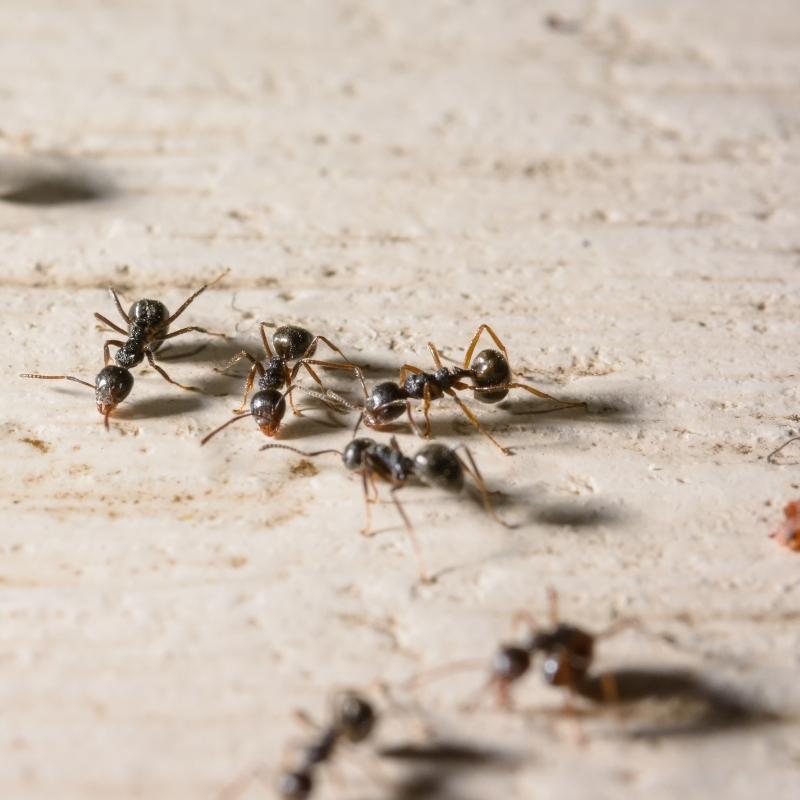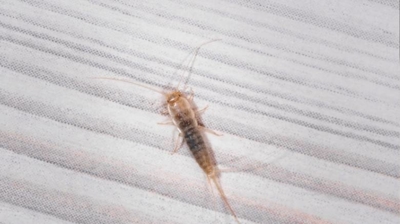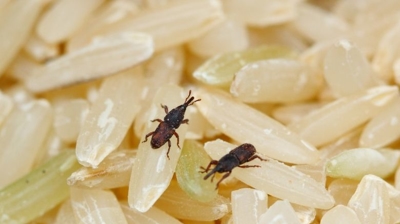
Odorous House Ant Control Services

Odorous House Ants
Odorous house ants (Tapinoma sessile), also known as sugar ants, are not directly dangerous to human health in the way some other ants are, but they are still considered harmful in several ways:
- Food Contamination and Sanitation Risk: These ants actively forage in unsanitary areas such as garbage, drains, and outdoor decaying matter, then enter kitchens, pantries, and food prep surfaces. As they crawl across food and food-contact surfaces, they can contaminate human food with bacteria and pathogens picked up from dirty environments. In restaurants, grocery stores, and food processing facilities, their presence can trigger health code violations and damage brand reputation.
- Persistent Infestations: Each colony can contain hundreds of queens and thousands of workers, making complete eradication challenging. When disturbed (e.g., by sprays or environmental changes), colonies split into satellite nests, multiplying the infestation. This makes them harder to control than many other ant species. They readily nest inside wall voids, under floors, and near moisture sources, where they can remain hidden and protected.
- Structural and Aesthetic Damage: Not directly destructive, but their nesting habits can signal the presence of increased moisture problems, since they prefer to nest in already damp areas (e.g., leaky plumbing, bathrooms, basements). Their ant trails are unsightly, as they visibly forage in kitchens, around windows, and inside cabinets. They also have the potential to damage insulation and wall voids when infestations grow unchecked.
Learn more: Do Odorous House Ants Bite? || What Do Odorous House Ants Eat?
Odorous House Ant Removal
Odorous house ants may look harmless, but there are several reasons why eliminating them quickly is important—both for sanitation and for preventing long-term infestations:
- They contaminate food and food-prep surfaces: These ants are attracted to sweets, proteins, and moisture. As they forage, they crawl across floors, trash areas, drains, and other unsanitary surfaces. When they reach your food or countertops, they can transfer bacteria and pathogens, creating a genuine hygiene risk.
- They reproduce and expand extremely fast: Unlike some ant species that maintain a single queen, odorous house ants can have multiple queens and multiple interconnected nests. This makes the colony resilient and capable of spreading through walls, insulation, and cabinetry much faster than people expect. Ignoring them allows the colony to balloon into a much larger and harder-to-control problem.
- Killing them incorrectly can make the infestation worse: If homeowners use repellant sprays, they often trigger “budding,” where the colony splits into several new colonies. Instead of solving the problem, it spreads it throughout the home. Proper elimination requires targeted baiting and colony-level control.
- They can invade appliances and structural voids: Odorous house ants often set up satellite nests inside electrical devices, wall voids, under floors, and even inside insulation. This can lead to appliance malfunctions, wiring issues, and endless reinfestation cycles unless the colony is fully removed.
- They cause persistent odor issues: When crushed, they release a strong, rotten-coconut smell. In large infestations, this odor can become noticeable around nesting sites or even throughout a room.
Odorous house ants are extremely resourceful, long-lived, and able to survive in a wide range of indoor environments. Once they establish themselves, it’s almost guaranteed they’ll stay without our professional intervention.
Learn more: How To Get Rid Of Odorous House Ants
Odorous House Ant Control
Odorous house ants are one of the more frustrating household ants because of their persistence, adaptability, and the difficulty of eliminating them fully with DIY methods. Here’s why hiring our professional pest control is the best option for dealing with these ants:
- Accurate Identification: Many ants look alike, but proper identification is critical. Odorous house ants can be mistaken for little black ants or pavement ants, leading to wasted time and ineffective treatments if the wrong strategy is used. Our professionals know the differences and apply targeted methods.
- Understanding Colony Behavior: Odorous house ants have large, multi-queen colonies that can split into multiple satellite nests. When disturbed or improperly treated, they often “bud” and form new colonies, making infestations spread. Our professionals know how to treat without causing colony budding.
- Targeted Treatment Plans: Store-bought sprays and baits may provide temporary relief, but most do not penetrate the entire colony or address hidden nests. Our pest control experts use professional-grade products and methods that are specifically designed for odorous house ants’ feeding and nesting habits.
- Safe, Effective Solutions: Our professionals know how to apply treatments safely around children, pets, and food areas. We also use products not available to the general public, giving you stronger and longer-lasting control.
- Inspection and Prevention: Our professionals won’t just treat the ants; they’ll inspect your property for entry points, moisture issues, and food sources that are attracting the ants, helping prevent future infestations.
- Saves Time and Money: DIY attempts often lead to repeated infestations, wasted money on ineffective products, and growing frustration. Our professionals eliminate the problem correctly the first time and help protect your home from future outbreaks.
Instead of dealing with trails of ants in your kitchen or bathroom and the constant worry of them coming back, our professional services give you confidence that your home is protected long-term.
Odorous House Ant Exterminators
Hiring our local exterminators gives you a clear advantage when dealing with odorous house ants, because the success of treatment depends heavily on correctly identifying colony behavior, choosing the right bait strategies, and understanding how these ants behave in the region. Here’s why our local expertise outperforms national brands for this particular pest:
- Better understanding of regional ant biology and seasonal patterns: Odorous house ants behave differently depending on local climate, humidity, forage patterns, and overwintering habits. Our local technicians deal with these exact conditions daily, so we know when colonies are most active, where they typically nest in the area, and which treatment methods work best.
- More flexible and customized treatment plans: National companies often use standardized service protocols that may not account for the quirks of the multi-queen, budding odorous house ant colonies. Our local exterminators provide more adaptable strategies—adjusting bait types, rotation schedules, and follow-up timing based on what’s happening in your home rather than what the corporate playbook says.
- Faster response times and more consistent service: When dealing with odorous house ants, delays allow colonies to expand and create satellite nests. Our local team can usually get onsite faster and more consistently provide the same technician for ongoing services, which improves success in tracking colony movement and verifying that our treatments are working.
- Greater accountability and relationship-based service: Our local exterminators depend on our community reputation, not a national advertising budget. That translates into more thorough inspections, tailored recommendations, and solutions designed to eliminate the problem—not just manage it under a one-size-fits-all subscription.
- Deep knowledge of local construction styles: Many infestations persist because ants hide in structural voids. Our local pros know the common construction patterns in the area—slab-on-grade homes, crawlspaces, older framing styles, moisture-prone areas—and can target our treatments more precisely.
Our local exterminators have broader flexibility to use specialty baits or targeted non-repellent treatments proven to work against the region’s ant populations. National companies are often limited to corporate-approved product lists, even if those options aren’t ideal for odorous house ants.
What Do Odorous House Ants Look Like?
Odorous house ants (Tapinoma sessile) are small, dark-colored ants that can be easily mistaken for other common household ants at a glance. However, they have several distinct physical characteristics that help with accurate identification:
- Size: Adults are very small, typically ranging from 1/16 to 1/8 inch (approximately 2.4 to 3.3 mm) in length.
- Color: Varies from dark brown to black, sometimes with a slightly reddish-brown hue depending on lighting and age.
- Body Shape: Like all ants, they have three distinct body segments: head, thorax, and abdomen. Their thorax is uneven in profile when viewed from the side, which helps distinguish them from some other ants that have a more smoothly rounded thorax. The abdomen is oval and relatively large compared to the rest of the body.
- Waist (Petiole): A single small node (petiole) between the thorax and abdomen, which is not visible from above because it is tucked under the abdomen. This hidden petiole differentiates them from other ants with more prominent nodes (like pavement ants or Argentine ants).
- Antennae: They have 12-segmented antennae with no club at the end. The antennae are long and slightly curved.
- Legs: Six legs, typically pale to brownish in color, depending on the individual.
- Texture and Surface: Their bodies are smooth and lack noticeable hairs. They have a shiny appearance, especially under magnification.
- Odor (Not visible, but key to identification): When crushed, they emit a strong, rotten coconut or blue cheese-like smell due to specific chemical compounds (especially iridomyrmecin). This odor is one of the most distinctive traits used in field identification.
Where Are Odorous House Ants Found?
Odorous house ants (Tapinoma sessile) are commonly found in areas that provide food, moisture, and shelter. Here are the most likely places you might find them:
Indoors:
- Kitchen & Pantry – They are attracted to sugary foods, grease, and crumbs.
- Under Sinks & Appliances – Moisture attracts them, so check near dishwashers, refrigerators, and under sinks.
- Wall Voids & Electrical Outlets – They often nest inside walls, behind baseboards, or in electrical boxes.
- Cabinets & Cupboards – They seek out stored food, especially sweets.
- Bathrooms & Laundry Rooms – Leaky pipes and damp conditions make these areas ideal nesting spots.
Outdoors:
- Under Rocks, Logs, & Mulch – They often nest beneath stones, landscaping materials, or leaf litter.
- In Soil Near Buildings – They prefer nesting in loose soil, particularly around foundations and along sidewalks.
- Rotting Wood & Tree Stumps – Decaying wood provides them with a protective nesting environment.
- Under Siding & Near Windows – Small gaps in exterior siding or around windows offer easy entry points.
- Along Pavement & Driveways – Cracks in concrete or gaps in pavement can serve as nesting locations.
If you suspect an infestation, follow their trails to locate their nest. Since they are highly adaptable, colonies may relocate quickly when disturbed.
What Do Odorous House Ants Eat?
Odorous house ants are omnivorous insects with a diverse diet. They feed on a variety of food sources, including:
- Sugary Substances: Odorous house ants are particularly attracted to sugary foods like nectar, honeydew produced by aphids, and sweet spills or residues in kitchens. They have a strong affinity for sugary substances.
- Proteins: These ants also consume protein-rich foods, such as dead insects, small invertebrates, and even pet food. They are opportunistic scavengers and will readily feed on protein sources.
- Fruits: Odorous house ants may forage on ripe or overripe fruits, attracted by the sugars present in the fruit juices.
- Household Crumbs: They are known to scavenge for food scraps and crumbs in homes, including bread, cookies, and other human food items.
- Honeydew: In outdoor settings, they often tend to honeydew-producing insects like aphids and scale insects, feeding on the sweet excretions these insects produce.
- Plant Nectar: These ants also visit flowers to collect nectar, which serves as a carbohydrate-rich food source.
Their adaptable diet and ability to exploit various food sources make odorous house ants common household pests, as they can easily find and access food within homes and outdoor environments. To manage infestations, it's crucial to eliminate food sources and employ effective pest control methods.
Odorous House Ant Life Cycle
The life cycle of the odorous house ant (Tapinoma sessile) consists of several stages, including egg, larva, pupa, and adult, and follows a typical pattern seen in many ant species:
- Egg Stage: The life cycle begins when a mated queen lays eggs. These eggs are tiny, oval-shaped, and white. The queen typically starts with a small number of eggs and gradually increases her egg-laying as the colony matures.
- Larva Stage: Once the eggs hatch, they become ant larvae. Larvae are legless, soft, and pale in color. During this stage, worker ants take on the responsibility of feeding the larvae. They feed them regurgitated food and care for them until they mature.
- Pupa Stage: After a period of growth, the ant larvae spin a silk cocoon around themselves and enter the pupal stage. Inside the cocoon, they undergo metamorphosis, where their body structures develop and mature. During this stage, they go through significant changes to become adult ants.
- Adult Stage: When the pupal development is complete, adult ants emerge from their cocoons. These are the ants that you typically see foraging for food and tending to the needs of the colony. The colony consists of worker ants, the queen, and sometimes male ants.
- Worker Ants: The majority of the colony consists of sterile female worker ants. They are responsible for tasks such as foraging for food, caring for the queen and larvae, defending the colony, and maintaining the nest.
- Queen Ant: The queen is the reproductive female in the colony. Her primary role is to lay eggs and maintain the colony's population. She can live for several years and is typically the largest ant in the colony.
- Male Ants: Male ants are produced when the colony is mature and needs to produce new queens and males for reproduction. Their primary role is to mate with new queens during nuptial flights.
The life cycle of odorous house ants is influenced by factors like temperature, food availability, and colony needs. Colonies can vary in size, and the time it takes for eggs to develop into adults can range from several weeks to several months. Throughout their life cycle, odorous house ants work together as a colony to ensure the survival and growth of their population.

Hear From Our Happy Customers
-
"Very Knowledgeable"
The tech that arrived was courteous, professional, and very knowledgeable. He was Great.
- Uerial I. -
"Exceeds Expectations"
I can’t say enough positive things about this company... The tech that came out, Jarvis went above and beyond my expectations. Thank you guys, I will continue using your services.
- Jake M. -
"Fantastic & Patient"
Jarvis was fantastic and patient. He answered my questions with an in-depth explanation and addressed all of my areas of concern. Would love for him to be my assigned tech going forward. Well done!
- Yonnette M. -
"Wonderful Service"
Wonderful service. Jarvis is great. Took care of everything I needed. Thank you!
- Henry P. -
"Great Communication"
Tech was on time, communication was great, and he accommodated my needs.
- Alonzo W. -
"Professional & Considerate"
I’m pleased with Miche services. Jarvis came today. Professional and considerate. Thank you!
- Judy B.



